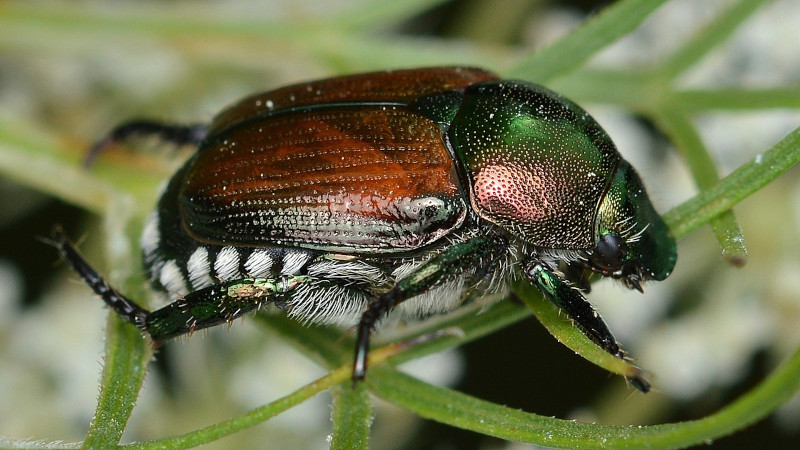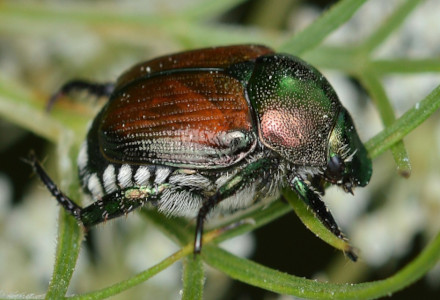
Japanese Beetle Facts
- This controversial product of Nature and evolution most frequently goes by the english language name of the Japanese Beetle outside its native range. For the moment, the invertebrate has no other widely accepted general title in the english language.
- Within the scientific community, however, the insect’s likely better known by its technical appellation. Fortunately for the layperson, that’s a relatively simple term to pronounce, compared to many. That’s because it hold the epithet of Popillia japonica.
- The Arthropod received that particular designation due to the efforts of Edward Newman. The respected English entomologist recorded the first official recognition of it as a separate and distinct species. He accomplished that notable feat in 1841.
- Regardless of which of these terms one chooses to use when referring to it, the species remains one of considerable reputation. In its native range, it’s largely harmless, due to the presence of natural predators. Outside that area, though, it’s considered invasive.
- For the moment, the Japanese Beetle has a population base that’s both large and apparently stable. That situation also seems to hold true in all areas it now inhabits. The IUCN thus currently has no listing for the insect on the organization’s Red List.
- The creature nevertheless should be considered to be facing at least some threats to its continued existence as a species. Like most life on this planet, the majority of those stem from the actions of manking. These perils include habitat loss and climate change.
Related Articles
Japanese Beetle Physical Description
The fascinating Japanese Beetle often stirs appreciation and respect for its physical qualities, if not for its habits. The invertebrate typically does so, however, due more to its appearance than its size. That’s true since, in that respect, it’s a moderately small beetle variety.
In regards to physical attributes, though, it does follow a pattern common to many species. That’s in the fact that the beetle displays a certain degree of the physiological characteristic of sexual dimorphism. In its case, this trait manifests itself in terms of sheer body size.
More specifically, males typically attain smaller measurements than their female counterparts. The difference between the two, however, remains comparatively minor. Distinguishing the genders visually is thus usually quite difficult for the untrained observer.
Overal, individuals of both sexes reach total lengths equaling approxmately 0.6 in (1.5 cm). The mean width of each further measures an average of roughly 0.4 in (1 cm). Though exceptional specimens do occur, they rarely exceed these dimensions by very much.
Yet, it’s the coloring of the amazing Japanese Beetle that generally garners the most attention. Folded back over the body when not in use, the wings present am iridescent copper shade. The small head and thorax, meanwhile, usually display a deep, shiny green.
On each side of the body, a row of white hairs project from under the wing covers. Each of the strong, black-colored legs also present multiple sharp hook-like barbs. Like many insects, two small antennae additionally appear on the head of the creature, near the large eyes.
- Kingdom: Animalia
- Phylum: Animalia
- Class: Arthropoda
- Class: Insecta
- Order: Coleoptera
- Family: Scarabaeidae
- Genus: Popillia
- Species: P. japonica
Japanese Beetle Distribution, Habitat, and Ecology
The remarkable Japanese Beetle evolved as native to a relatively small region of the surface of the earth. No evidence exists that it ever spread beyond that zone of habitation on its own. The actions man, however, have since spread it across much of the globe.
In the broader term, the Arthropod developed as endemic to only a limited, and very specific, portion of Asia. As its name clearly implies, that consists of the island nation of Japan. Yet, even within that larger area, it only lives natively on a few of the larger islands.
Due to its evolution, this marvel of Nature displays an extreme flexibility in regards to its choice of habitat. It thrives equally well, and has spread to, regions of both temperate and tropical climates. It essentially lives anywhere it’s warm enough and with sufficient food.
This primarily includes regions of deciduous forests, since these have the greatest concentration of the appropriate plants. Yet, it’s not limited to these areas. It’s also quite common in places such as parks, grasslands, farms, fields, and even home gardens and yards.
The Japanese Beetle evolved as purely herbivorous in nature. Mature adults feed voraciously, typically on the leafy parts of plants above ground. The larvae, meanwhile, consume in equally large quantities the roots. Over 300 flora species fall vicctim to this insect’s appetite.
Following mating, females lay eggs either singly or in small groups. These she places near the ground. Hatching generally requires about two weeks. The lifespan of this creature varies, depending on its location, but generally lasts between 1 – 2 years in most areas.
Species Sharing Its Range
Check out our other articles on 4 Remarkable Reptiles of Australia, Eurasian Brown Bear, Mount Jade, Cheddar Pink, Spinetail mobula, Fire Salamander, Philippine Cobra

